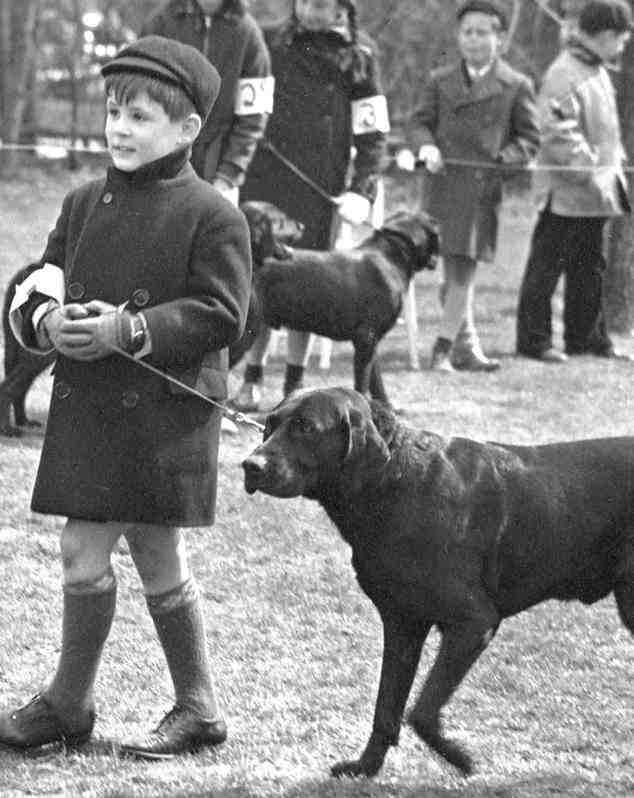
American Peaked Cap: Conventions

Figure 1.--The photograph here shows a charity dog show. It was the the Oak Lodge Benefit Dog Show held on the estate of George de Dern (Venu?) in Cedarhurst, Long Island. We susspect that the participants were the well-to-do country club set. Note the boy wearing a peaked cap, probably with a suit. We can tell because he is wearing an overcoat. Note the boys in the background also wearing peaked caps. The photograph was taken April 12, 1942.
|
|
We see peaked caps worn in several different countries and the conventions associated with these caps varied. The peaked cap was in Britain associated with schoolwear and to aesser extent the Cub Scouts. In America, the peaked cap was primarily a dress cap, but there were some other conventions. We see boys wearing them as a dress cap in the late-19th century. As in Britain and other countries, Cub Scouts wore them. And we think they were worn at a few private schools. For a brief period, around the turn of the 20th century, we seem them bring worn as one of several styles of caps worn by boys as a kind of casual cap.
Dress Cap
American boys primarily wore the peaked cap as a dress cap. We see boys wearing them as a dress cap in the late-19th century. We see them being worn with kilt suits, Fauntleroy suits, sailor suits, and other styles. The age conventions seem more associated with the suit than the cap. Most of the examples we have found are boys dressed up. A good example are two unidentified boys about 1910. After World War I the convention of wearing them with regular suits became more standardized. This could reflect the fact that fewer children were photographed in casual clothing. Most 19th century photography was studio portraits. We continue to see boys wearing them as a dress cap with a suit through the 1960s. This was the most common cap style worn with short pants suits, especially the Eton suits worn by younger American boys. We see quite a number of photographs of American boys wearing Eton suits with peaked hats. The caps were made to match the suits. The style had an upperclass look to it in the eyes of most Americans, especially when combined with short pants. We see both family snapshots and advertisements, such as an insurance ad in the 1960s. We believe that it was popular in America in part because of its English association. We note them being more commonly worn by boys from well-off or at least comfortable middle class families. After the 1960s these peaked caps were still worn, but mostly by pre-school boys. This was the cap worn by American boys from affluent families, normally with a suit and done to match the suit. There were social class connotations. Flat caps were more common. These caps were especially popular with affluent families.
Sports
We believe we have seem bicyclists wearing these caps.
The original baseball players wore peaked caps.
Schools
We think that a few private American schools may have used the cap as part of the uniform as in Britain. School boys in America wore peaked caps at the turn of the 20th century, although not as part of a uniform. The exception here is boys attending private schools. A good example is Frank Bailey about 1915. They were worn by sports teams as some private school just as in England. Some exclisive private schools did adopt them as a uniform, but not in the bright colors and fancy designs as in England. This may have been one of the original conduits for the style from Britain to America. We also see boys of all social classes wearing them to school in the 1900s until the flat cap became dominant in the 1910s.
Casual Cap
For a brief period, around the turn-of-the 20th century, we seem them bring worn as one of several styles of caps worn by boys as a kind of casual cap. We see quite a few boys wearing them. There was no dominant style in the 1900s, so we see boys wearing several styles. And there was no decided social conventiins. We see wealthy boys wearing them as well as boys who left school and had to work. For this brief period, there were no social class conventions. We seen them being worn by working-class boys. A good example is newsboy Simmon Mellito in 1910. This changed during the 1910s and by the 1920s these peaked caps in the United States had a very definite class image and wwre no longer commonly worn. Gradually the flat cap replaced the praked cap as the most popular boys' style.
Cub Cap
As in Britain and other countries, American Cub Scouts wore them. Cubbing was introduced in American Scouting in 1930s and wore the sane blue and gold cap for 50 years until 1981.
Summer Camp
We also notice these caps being worn at a summer camp in 1905. Although we are not entirely sure if these were a camp or a school cap.
HBC

Navigate the Boys' Historical Clothing Web Site:
[Return to the Main American peaked cap page]
[Return to the Main peaked cap style page]
[Return to the Main cap page]
[Introduction]
[Activities]
[Bibliographies]
[Biographies]
[Chronology]
[Clothing styles]
[Countries]
[Literary]
[Bibliographies]
[Contributions]
[FAQs]
[Glossaries]
[Images]
[Links]
[Registration]
[Tools]
[Boys' Clothing Home]
Created: 2:55 AM 12/20/2006
Last updated: 10:05 PM 2/4/2011



